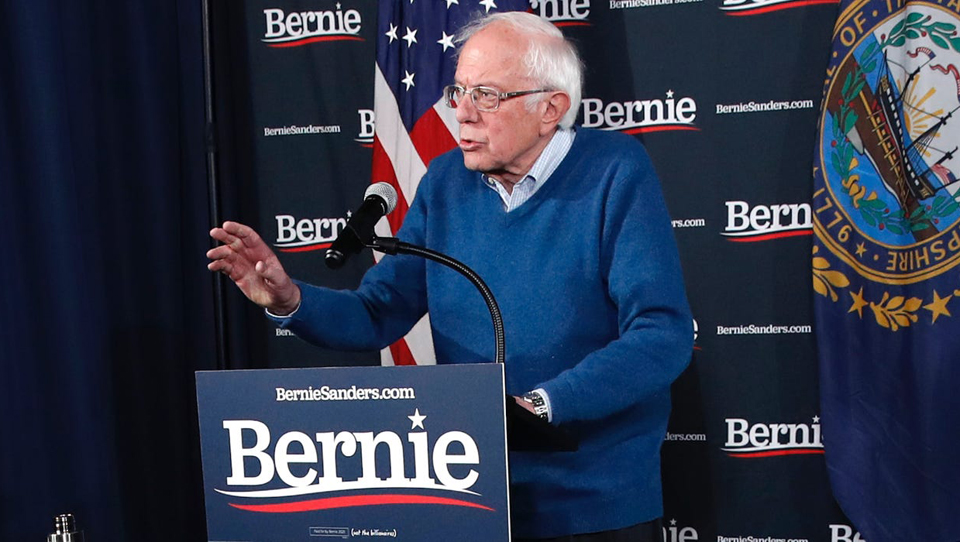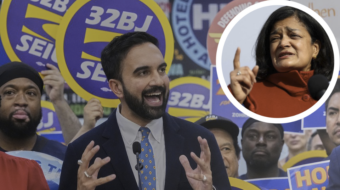
DES MOINES, Iowa – Confusion surrounding the Iowa Caucus results continued Feb. 6 after Democratic National Committee chair Tom Perez called for a re-canvass of votes to ensure their full integrity. The chaos is likely the final nail in the coffin of the Iowa caucus, long criticized as undemocratic and unrepresentative of Democratic base voters.
Obscured in all this was a historical outcome – the victory of Sen. Bernie Sanders, I-Vt., a self-declared democratic socialist. Sanders won by approximately 3,000 votes over 2nd place finisher, former South Bend mayor Pete Buttigieg, an openly gay man.
Sen. Elizabeth Warren, D-Mass., finished third, followed by former Vice President Joe Biden, a showing widely seen as damaging to his campaign.
As of now, Sanders and Buttigieg will each be awarded 11 of 41 delegates to the Democratic National Convention. Warren will receive five delegates.
Sanders victory
Candidates spent the past year crisscrossing the state, engaging hundreds of thousands of voters, speaking before mass rallies, town halls, and intimate gatherings. For their part, voters took the whole process very seriously, weighing many factors as they decided whom to support.
Sanders won based on a program of large-scale economic and political change, including universal health care, climate justice, and free public college tuition. But Sanders also had an extensive ground operation that made over 500,000 voter contacts in January alone and a campaign flush with grassroots donations.
Buttigieg and Warren had substantial campaign operations too. The Sanders campaign reached 75% of caucus-goers, and Warren and Buttigieg reached 66%.
Sanders won, especially in urban areas and college towns, among young voters and 67% of caucus-goers who identified themselves as liberal or very liberal. He carried predominantly Latino and African American precincts and dominated the 87 satellite caucuses, including a caucus of Spanish speakers.
Sanders won about half of the voters under 30 years old, although this was down from 84% in 2016. He won 44% of LGBTQ voters, the rest split between Warren and Buttigieg. He lost support among voters 30-45 years old from levels he enjoyed in 2016.
Buttigieg showed support among moderate voters, surprisingly among youth, and 22% of LGTBQ voters. He won 61 of Iowa’s 99 counties, demonstrating support in rural and suburban areas. But Buttigieg had little support in communities of color, the Achilles heel of his campaign. Influences of homophobia, and 57% of voters who felt a gay candidate would have a hard time beating Trump, likely hurt him.
Warren consistently finished among the top candidates in precincts across the state. She was narrowly favored by women voters, particularly young women and college graduates, and ran stronger in suburban areas. She also did well among liberal voters. Sexism and the perception among 45% of caucus-goers who felt a woman candidate would have a harder time against Trump undoubtedly hurt Warren.
For Biden, the results were disappointing. A poorly run campaign operation, which left many caucus sites staffed by out-of-staters, hurt his vote. The illegal scheme cooked up by Trump and Giuliani to use Ukraine to tarnish his image with corruption and charges of nepotism, may also have hurt Biden’s image. That said, Biden was supposed to do well among seniors and working-class whites, especially in eastern Iowa. He came up short among both groups.
However, despite his poor showing, Biden shouldn’t be counted out yet. He still enjoys the support, although fragile, of the Democratic establishment, many elected officials, some labor unions, older voters, moderates, and many African-American voters.
Many expected turn out to exceed the record 238,000 set in 2008, based on the broad democratic upsurge and intense hatred of Trump. In the end, turnout was 176,000, only slightly better than 2016, despite reforms won by the Sanders campaign that included the 87 satellite caucuses, including for shift workers and Spanish speakers.
One reason for the lower than expected turnout may have been the high level of undecideds going into the caucuses. Many people agonized over the vast field of candidates, finding multiple candidates appealing. One-third of caucus-goers decided on their preferred candidate only in the last few days or on the last day of the caucus.
Challenges looming
Sanders heads into New Hampshire as the front runner. However, he and the rest of the Democratic field face enormous challenges. As the primaries head to far more racially diverse states of South Carolina, Nevada, and Super Tuesday, the dynamics of the primary will change markedly.
The candidate best able to appeal to the broadest swath and the most diverse universe of voters, especially with strong relationships with African American and Latino communities, has the best chance to emerge victoriously. They will be the candidate who can most effectively integrate issues of economic, racial, and gender equity, of protecting democracy and addressing the climate crisis.
The primaries will be additionally complicated by the presence of former New York City mayor and billionaire Michael Bloomberg and fellow billionaire Tom Steyer.
Bloomberg has already spent $500 million, more than all the other candidates combined, on wall-to-wall media exposure. His campaign announced they would double-spending, effectively crowding out media exposure for all the other campaigns. Bloomberg can also count on his connections to networks on gun safety and the climate crisis, which he has funded lavishly.
But voters are also making judgments on which candidate they feel best able to defeat Trump. Two-thirds of Iowa caucus-goers said beating Trump was the top priority, and for some, the only priority. For many, this was more important than full agreement on the issues. In my interviews with voters, to a person, they said they would support whoever the eventual nominee is.
Sharpening tensions between campaigns is only natural, but keeping an eye on defeating Trump and maintaining the broad unity of the anti-Trump coalition is paramount. For some of those on the left who see the Democratic establishment as the main enemy, it can’t be “my way or the highway.” And at the same time, for moderates and establishment forces, it can’t be, “anybody but Bernie.”
Tens of millions already know to defeat Trump and the GOP, regardless of which Democrat is elected, ends the immediate national nightmare and the siege of our democratic institutions. A victory opens the door to move toward greater access to universal health care, addressing the climate crisis, worker rights, mass incarceration, and immigration reform, etc. and creates new space and influence for the mass movements to propel these demands forward.
For example, finding unity on the health care issue calls for flexibility. It’s clear Trump and the GOP are out to dismantle Obamacare completely. While 70% of Iowa caucus-goers favored a single-payer system, 90% also favored a public option, and 60% supported both. Many union members who have health insurance won through collective bargaining agreements have doubts about giving up what they already have for a promise of something better.
It will take an Obama campaign type movement and a historic voter turnout to defeat Trump, one that merges with the vast upsurge to defend democracy sweeping the country. It will take a campaign-movement with deep connections to multi-racial working-class communities, to women who are leading many struggles, other social strata, the LGBTQ community, immigrants, youth, seniors, liberals, moderates, independents, and Democratic party regulars. It will take a campaign that embraces all social movements, including around gun safety, climate crisis, mass incarceration, immigration reform, disability, and reproductive rights.
Trump clearly outlined his line of attack during his state of the Union address, which doubled as a campaign kick-off. He will shroud the country in a veil of lies extolling his administration’s accomplishments. Meanwhile, Trump will invoke a new “red scare” of rabid socialists threatening to impose “government” healthcare at home while embracing totalitarian dictators abroad, of open borders that permit immigrants to swarm the U.S. committing murder and mayhem. He intends to double down on racism, Islamophobia, anti-Semitism, and misogyny.
Challenging Trump by exposing those lies will be critical to broadening the coalition that will vote him out. Millions of Trump voters, for example, either desperately need or directly benefit from Obamacare provisions that protect those with pre-existing conditions. Trump lies to them when he says he will do this while his administration battles in court to take that protection away. Like most people, Trump voters don’t like being cheated or lied to. As for the Democratic candidates: They would do much better exposing these lies than by attacking one another.
And, now acquitted in the Senate impeachment (sham) trial on charges of extortion and bribery to solicit foreign interference in the 2020 elections on his behalf, and then obstructing the investigation, Trump will now feel emboldened to commit new crimes including again inviting interference by foreign powers. Trump’s unprecedented campaign of ugliness and disinformation, including disruptions of the election process and massive voter suppression, will confront something else unprecedented – a mass democratic movement intent on mobilizing a historic voter turnout to oust him and his GOP enablers.










